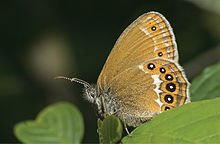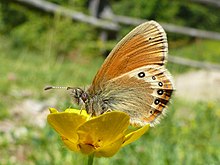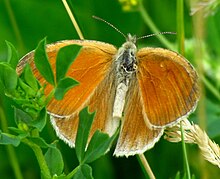Coenonympha
| Coenonympha | ||||||||||
|---|---|---|---|---|---|---|---|---|---|---|

Panel from Adalbert Seitz 'Big Butterflies of the World |
||||||||||
| Systematics | ||||||||||
|
||||||||||
| Scientific name | ||||||||||
| Coenonympha | ||||||||||
| Huebner , 1819 |






Coenonympha is a genus of butterflies comprising more than 30 species from the subfamily of the eye butterflies(Satyrinae) in the family of the noble butterflies (Nymphalidae). The genus is distributed Holarctic and mostly lives in grassy habitats. Species with a German name are called meadow birds.
features
Imago
The Coenonympha are small butterflies with cloudy colors, mostly yellow to dark brown, rarely whitish in color. They are either eyeless on the top of the wings or have one eye in the apex, and sometimes multiple eyes on the hind wings. The outer edge of the hind wings is almost circular, rarely with a slightly wavy edge, sometimes pulled forward at the anal angle. The underside is mostly adapted to gray sand, but on the hind wing sometimes with shiny metallic lines on the outer edge and show - especially in the forest-dwelling species - a series of pithead eye spots. The eyes are bare, the palms long, erect and pointed, with long-bristled, protruding hair. The antennae are delicate, less than half the costal length and hardly noticeably thickened at the end.
Pre-imaginal stages
The eggs are elongated and have longitudinal ribs. The green, slightly hairy caterpillars are delicate with a spherical head and pointed at the back. The squat plump doll is green or gray.
distribution
The genus with over 30 species occurs mainly in the Palearctic , four of them in northern Africa. Two types occur in the Nearctic . In Europe, the genus occurs from northern Spain across continental Europe and the British Isles to the Arctic Circle. To the east the distribution area extends to Mongolia, China and Korea. The large Mediterranean islands ( Balearic Islands , Sardinia , Corsica and Crete ) are also populated. In the Middle East, the distribution extends in the south to Lebanon .
Way of life
The species of the genus Coenonympha mostly live in grassy habitats , where they are sometimes very numerous. For caterpillars to develop, the nature of the habitats, such as the degree of shrubbery, nutrient content and microclimate, is more important than the occurrence of certain types of grass. The moths lay the eggs one by one on litter or directly on the grass on which the caterpillars feed. The caterpillar overwinters in all species. The pupa hangs on stems or stones near the ground. The Coenonympha form one to three generations a year, whereby the multi-brood ( polyvoltine ) species form fewer generations in northern or high-altitude habitats. Exposed bushes serve the territorial species as courtship grounds, where the males wait for unfertilized females. In non-territorial species, the males fly around looking for females. The moths are lateral absorption suns and therefore close their wings immediately after landing and place one underside of the wing perpendicular to the sun. Depending on the position of the sun, they can almost lie down. Investigations on north-western European species showed that open land species have a longer lifespan and higher egg production than forest species.
Danger
Some species of the genus are among the most endangered butterfly species in Europe. The river valley meadow bird ( C. oedippus ) is threatened with extinction. The forest meadow bird ( C. hero ) and the large meadow bird ( C. tullia ) are very endangered. In North America, the Coenonympha nipisiquit , which occurs only very locally on the Canadian east coast, is endangered by habitat change and loss.
Taxonomy and systematics
The relationships within and outside of the genus have long been unclear and have not been finally clarified. Genetic studies by Kodandaramaiah and Wahlberg from 2009 led to the fact that the genera Lyela Swinhoe , 1908 with three species ( mcmahoni , amirica and myops ) and Triphysa Zeller , in 1850 with two species ( phryne and albovenosa ) were synonymous with the genus Coenonympha , since Triphysa form a clade with the river valley meadow bird ( C. oedippus ) and Lyela with C. nolckeni .
External system
The relationships in the butterfly subfamily are not yet fully understood. After genetic analyzes the genera form Oreixenica , Tisiphone , Nesoxenica , Hypocysta , Lamprolenis , Dodonidia , Argyrophenga , Erebiola , Percnodaimon , Heteronympha , Geitoneura , Oressinoma , Orsotriaena , Zipaetis , Argyronympha together with Coenonympha the group Coenonymphina.
Internal system
Within the genus there are many species complexes with not clearly recognizable species boundaries. On the one hand, there are large variations within some species due to ecological differences in the individual habitats. On the other hand, there are hybrids at contact areas of species that are not genetically far apart . The large meadow bird ( Coenonympha tullia ), which occurs in Eurasia and North America, forms a particularly large number of ecological forms . The subspecies in the grasslands are much lighter than the forest dwellers. This species has another peculiarity, since the populations of Eurasia and North America differ genetically more strongly than the Eurasian population from the species C. amaryllis and C. rhodopensis separated in Eurasia . Species complexes form the white-bound meadow bird ( C. arcania ) with the Alpine meadow bird ( C. gardetta ) and its subspecies C. gardetta darwiniana , which form fertile hybrids in contact areas in the Alps. C. arcania is also genetically closely related to the forest meadow bird ( C. hero ), of which some, presumably sterile, hybrids are known from earlier contact areas, but in which C. hero is now extinct.
The species list summarizes some taxa, which some consider to be their own species. C. iphioides is considered a subspecies of C. glycerion as no species boundary has been established. C. corinna elbana is regarded by some authors as a distinct species. However, so far there are no publications on genetic studies that support these assumptions. C. gardetta darwiniana is considered by some authors as a separate species. C. orientalis is considered by some authors as a subspecies of C. gardetta or C. leander , the classification as a species is shared by the Lepiforum and Fauna Europaea.
- Coenonympha albovenosa Published , 1885 east of the Urals to the Amur region and Korea
-
Coenonympha amaryllis ( Stoll , 1782) Central and East Asia
- C. amaryllis simingica Murayama , 1986, China
- Coenonympha amirica ( Wyatt , 1961) Afghanistan
- White-headed meadow bird Coenonympha arcania ( Linnaeus , 1761) continental Europe
- Coenonympha arcanioides ( Pierret , 1837), also Moroccan hay butterfly, Northwest Africa
-
Coenonympha corinna ( Hübner , [1804]) Corsica , Sardinia , Elba , Tuscany
- C. corinna corinna , also Corsican hay butterfly, Corsica, Sardinia
- C. corinna elbana Staudinger , 1901, also Elba hay butterfly , Elba, Tuscany
- Coenonympha dorus ( Esper , 1782) Southwestern Europe
- Coenonympha fettigii Oberthür , 1874 Northwest Africa
-
Alpine meadow bird Coenonympha gardetta ( de Prunner , 1798) Alps, Central France, Balkans
- C. gardetta gardetta Alps
- C. gardetta lecerfi De Lesse , 1910 Central France ( Forez )
- C. gardetta darwiniana Staudinger , 1871, also Darwin's hay moth, Western Alps (Ticino)
-
Red-brown meadow bird Coenonympha glycerion ( Borkhausen , 1788) Eurasia
- C. glycerion alta Sheljuzhko , Caucasus
- C. glycerion beljaevi Dubatolov , 1997, Russian Far East
- C. glycerion heroides Christoph , 1893, Sacha (Yakutia)
- C. glycerion iphicles Staudinger , 1892
- C. glycerion iphioides Staudinger , 1870 Central and Northeast Spain
- C. glycerion korshunovi Nekrutenko , Crimea
- C. glycerion wutaica Murayama , 1986, Altai
- Coenonympha haydenii Edwards, WH , 1872 Northern Rocky Mountains, USA
- Forest meadow bird Coenonympha hero ( Linnaeus , 1761) temperate Palearctic
- Coenonympha leander ( Esper , 1784), also Russian hay butterfly, Southeastern Europe, Caucasus, Turkey
- Coenonympha lyllus ( Esper , 1805) Northwest Africa, Southern Iberian Peninsula, Balearic Islands , Sardinia, Lebanon, Kurdistan , Northeast Iran
- Coenonympha macmahoni ( Swinhoe 1908) Iran, Afghanistan and the Caucasus region
- Coenonympha mahometana ( Alpheraky , 1888) Central Asia: Tian Shan , Alatau
- Coenonympha mangeri Bang-Haas , 1927 Northern Afghanistan
- Coenonympha mongolica Alpheraky , 1881 eastern Kazakhstan, northwestern China
- Coenonympha myops ( Staudinger , 1881) western Kazakhstan, Turkmenia and Iran via southern Uzbekistan and Afghanistan to the Djungarian Alatau and the southern Altai .
- Coenonympha nipisiquit ( McDonnough , 1939) very local on the east coast of Canada
- Coenonympha nolckeni Verschoff , 1874 Central Asia
- Stromtal meadow bird Coenonympha oedippus ( Fabricius , 1787) temperate Palearctic
- Coenonympha orientalis Rebel , 1826 Balkans
- Small meadow bird Coenonympha pamphilus ( Linnaeus , 1758) Western Palearctic
- Coenonympha phryne ( Pallas , 1771) Southern Ukraine to Altai
- Coenonympha rhodopensis ( Elwes , 1900), also Rhodope hay butterfly, Italy & Balkans, Central Asia
- Coenonympha saadi ( Kollar , 1850) Southeast Turkey , Transcaucasia , Iraq and Iran
-
Coenonympha semenovi Alpheraky , 1887 Tibet and Western China
- C. semenovi jiadengyuica Huang & Murayama , 1992, Altai
- Coenonympha sinica Alpheraky , 1888 Tibet
- Coenonympha sunbecca ( Eversmann , 1843) Central Asia: Ferghana , Tian Shan, Alatau
- Coenonympha symphita Lederer , 1870 northeast Turkey to southwest Georgia
- Coenonympha thyrsis ( Freyer , 1845), also Cretan Heufalter, Crete
- Large meadow bird Coenonympha tullia ( Statius Müller , 1764) northern Holarctic with numerous subspecies
- Coenonympha vaucheri Blachier , 1905 Northwest Africa: High Atlas , Rif
Synonyms
- Phryne Herrich-Schäffer 1844 younger homonym of Phyrne Meigen , 1800 (Diptera)
- Triphysa Zeller 1850
- Lyela Swinhoe 1908
Origin of name
The name Coenonympha, pronounced Köno'nümfa, is derived from the Greek words κοινός, -η, -όν with the meanings common, common; general, ordinary, well-known, public; mean, low, vulgar; connected by community, related and η νύμφη, -ης, the nymph , ago. The name can be interpreted as related nymphs .
literature
- Martin Wiemers: The genus Coenonympha HÜBNER, 1819, in Europe: systematics, ecology and protection (Lepidoptera: Papilionoidea: Nymphalidae: Satyrinae) . In: Society for Butterfly Protection (ed.): Oedippus . No. 25 . Pensoft, June 30, 2007, pp. 1–42 ( ( Page no longer available , search in web archives: european-butterflies.ufz.de ) [accessed on June 23, 2012]).
- U. Kodandaramaiah, N. Wahlberg: Phylogeny and biogeography of Coenonympha butterflies (Nymphalidae: Satyrinae) . In: Systematic Entomology . tape 34 . Wiley, 2009, p. 315–323 ( nymphalidae.net [PDF; 529 kB ; accessed on June 23, 2012]).
- Carlos Peña, Niklas Wahlberg, Elisabet Weingartner, Ullasa Kodandaramaiah, Sören Nylin, André VL Freitas, Andrew VZ Brower: Higher level phylogeny of Satyrinae butteries (Lepidoptera: Nymphalidae) based on DNA sequence data . In: Molecular Phylogenetics and Evolution . tape 40 . Elsevier, 2006, p. 29–49 ( zoologi.su.se [PDF; accessed on June 23, 2012]).
- The Palaearctic butterflies . In: Adalbert Seitz (ed.): The large butterflies of the earth . tape 1 . Alfred Kernen, Stuttgart 1909.
Individual evidence
- ↑ a b c Seitz, pp. 141-143.
- ^ A b Walter Forster , Theodor A. Wohlfahrt : The butterflies of Central Europe. Volume 2: Butterflies. (Rhopalocera and Hesperiidae). Franckh'sche Verlagshandlung, Stuttgart 1955, DNB 456642188 , p. 48.
- ↑ Kodandaramaiah & Wahlberg 2009, p. 315.
- ↑ a b c Wiemers 2007, p. 2.
- ↑ a b Wiemers 2007, p. 6.
- ↑ a b Wiemers 2007, p. 7.
- ↑ Tagfalter II (Augenfalter (Satyridae), Bluebirds (Lycaenidae), Dickkopffalter (Hesperiidae)) . In: Günter Ebert , Erwin Rennwald (eds.): The butterflies of Baden-Württemberg . tape 2 . Ulmer Verlag, Stuttgart 1993, ISBN 3-8001-3459-4 , p. 110 .
- ↑ COSEWIC Assessment and Update Status Report on the Maritime Ringlet coenonympha nipisiquit in Canada. Ottawa, 2009, ISBN 978-1-100-12933-4 .
- ↑ Kodandaramaiah & Wahlberg 2009, p. 316.
- ↑ a b Kodandaramaiah & Wahlberg 2009, p. 318.
- ↑ Peña, Wahlberg et al. 2006, p. 31.
- ↑ James A. Scott: The butterflies of North America . Stanford University Press, Stanford, California 1986, ISBN 0-8047-1205-0 , pp. 80 .
- ↑ Wiemers 2007, p. 20.
- ↑ Wiemers 2007, p. 19.
- ↑ Wiemers 2007, p. 13.
- ↑ Wiemers 2007, p. 27.
- ^ Coenonympha orientalis. Lepiforum eV, accessed on June 25, 2012 .
- ^ Coenonympha orientalis. FaunaEuropaea, accessed May 11, 2009 .
- ^ Lyela myops. Russian-Insects.com, accessed June 26, 2012 .
- ^ Coenonympha. Tree of Life web project, accessed June 26, 2012 .
- ↑ Hans-Arnold Hürter: The scientific butterfly names, derivation and interpretation. Verlag Peter Pomp, Bottrop Essen 1998, ISBN 3-89355-176-X , p. 174.
